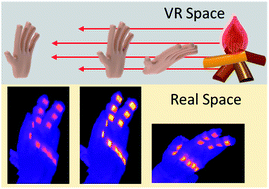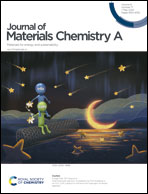Highly stretchable and oxidation-resistive Cu nanowire heater for replication of the feeling of heat in a virtual world†
Abstract
A thermal haptic device (THD) is used to implement temperature information in many virtual environments. The THD enables a user to feel the temperature as well as the thermal conductivity. Moreover, as temperature influences human emotion and preference, the THD enriches senses and experiences in a virtual environment. In this paper, we propose laser-assisted dual-function copper nanowire (CuNW) polyurethane acrylate (PUA) patterns for use as feedback controllable stretchable heaters as a 12-pixels THD, with highly enhanced mechanical and chemical durability. The CuNW–PUA pattern retains the stretchability from its serpentine mesh form, and the CuNW embedded in the PUA structure provides mechanical and chemical stability, facilitating a stable resistance. The CuNW–PUA pattern serves as a simultaneous heater and thermometer with accurate temperature control. Furthermore, the CuNW–PUA pattern is fabricated using a simple, fast, and elaborate laser process under ambient conditions. Finally, the CuNW–PUA pattern was used to realize heat transfer in various virtual environments in the form of 12-pixels on a nylon glove, showing potential for stretchable applications in next generation devices.



 Please wait while we load your content...
Please wait while we load your content...